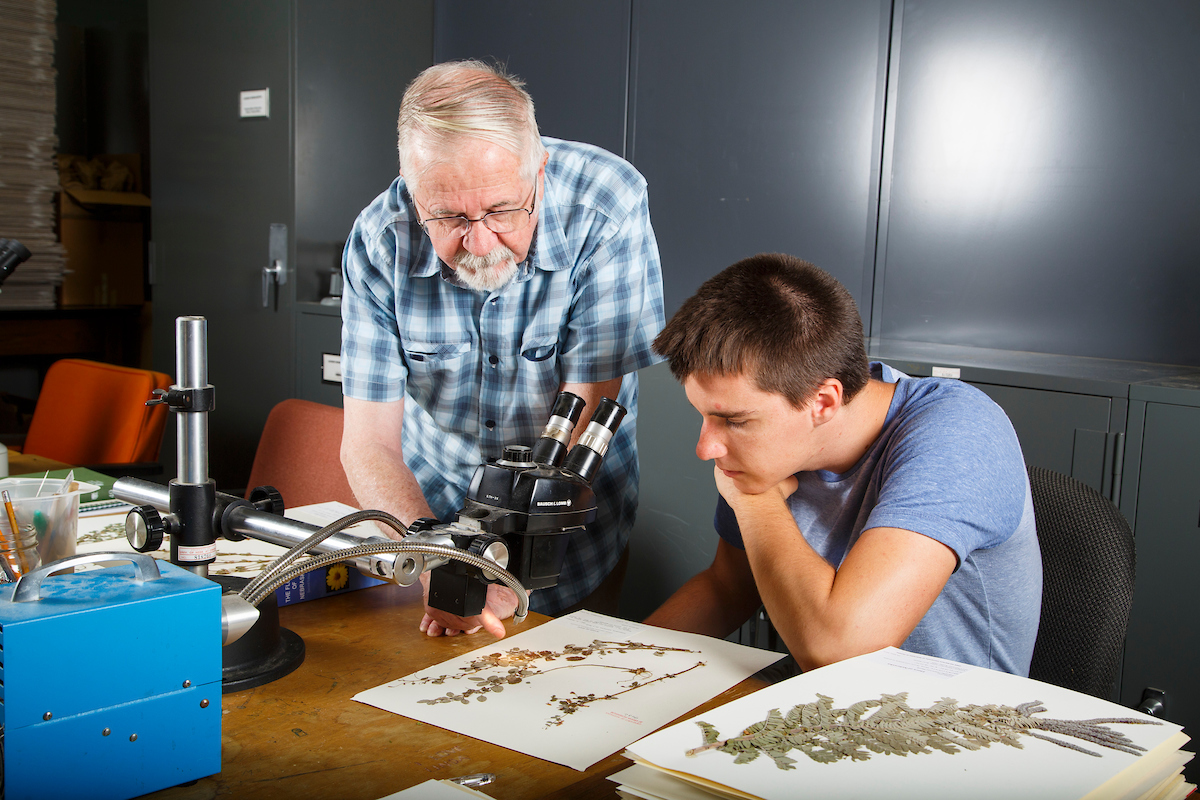The Legacy of the Herbarium: Science, History, Beauty, Adventure

What could be more romantic than building on the work of scientists from ages past and early explorers like Lewis and Clark in an unending quest to identify the 400,000 species of plants worldwide? Retired biology professors Dave Sutherland and Bob Egan probably wouldn't describe themselves as romantic heroes, but, if you visit the herbarium, they'll happily show you their treasure of 32,512 specimens of vascular plants and 20,000 specimens of lichens.
The Vascular Plants
Keeper of the vascular specimens since 1967, Sutherland explains, "A predecessor of mine, Dr. Merle Brooks, had several students who were enthusiastic about collecting plants, so there were about 500 mounted, student-collected plants here when I arrived. Since that time, I have built up the collection gradually with the help of many students and friends who have donated material."
Most specimens are from Nebraska, but some specimens from other states, Europe, and Australia are also available. Sutherland holds up two examples and adds, "some of the specimens are like works of art."
 The Lichen Collection
The Lichen Collection
In 1979, Egan brought the initial lichen collection from Texas A&M to UNO, but he explains that his interest in lichens dates back to his undergraduate work at Colorado.
"My first exposure to lichens, algae, fungi, mosses, etc., opened my eyes to organisms I had never really known anything about. 'Fascinating,' as Mr. Spock would say!"
"I have enjoyed working with colleagues around the world who study these organisms. There aren't very many of us, and we all know each other," adds Egan. "I have told my lichen students over the years that one result of this class will be to forever 'ruin your walks in the woods... you won't be able to keep your eyes off what is growing ont he ground, on the trees, or on the rocks!'"
The majority of the lichen specimens are from North America, but some are from Mexico, Costa Rica, and Guatemala.
The Adventures
Like many botanists, Sutherland and Egan also have tales of adventure to tell, their fieldwork often involving primitive accommodations and encounters with wildlife and dangerous weather.
Egan recalls his first class in lichenology at the University of Colorado. "Loveland Pass (alpine tundra environment at 12,000+ feet). Lovely June day. Coffee and doughnuts in Idaho Springs, then on up to the top of the Pass. In the first hour of collecting specimens we slowly progress up the mountainside hundreds of yards above the cars. Suddenly, it is snowing! A real white-out. We spend over 30 minutes huddled behind a rock outcrop before finally making our way back to the cars. Several students from out of state were particularly surprised, as they were wearing flip flops, T-shirts, and shorts!"
In addition to the trials of collecting specimens canoe-side and suddene ncounters with rattle snakes, Sutherland recalls a different sort of challenge in the field.
"When collecting along the road, I have been stopped by police a few times. They just wanted to know what was going on. I was out with a class one time near Monroe, NE, and the sheriff stopped by because he had a call from someone who reported that there were a group of young people from Omaha collecting marijuana along the road. He saw immediately that it was a class that included, among others, nuns in full habit."
Sutherland published Per Axel Rydberg's Botanical Collecting Trips to Western Nebraska in 1890 and 1891 as co-editor with Professor Robert B. Kaul of the Bessey Herbarium at UNL. The book includes not only Rydberg's list of specimens but a report of his adventures, as well as color photos from 2012 when Sutherland and Kaul retraced Rydberg's journey.
Published in 2006 and decidedly larger at 967 pages is the Flora of Nebraska, Second Edition, co-authored by Sutherland, Kaul, and Steven Rolfsmeier, herbarum director at Chadron State College. Publisher UNL describes the book that "covers nearly 2,000 species... and thousands of updates based on new plant sightings and on changes in taxonomy" as "not for the faint of heart... but the standard reference for serious botanists."
From time to time, Sutherland genuinely gets to save the day when the Poison Control Center calls him for help with plant identification. Last July, he was able to identify a leaf a child had eaten as Euonymus. In August, he got another call for a child who had eaten berries from Parthenocissus vitacea (woodbine). "These calls have become easier to deal with since so many people now have smartphones that take good pictures. It is very hard to figure out what a plant is from a description given by a distraught mother who is not familiar with botanical terms."
Sutherland's publications build on the work of others in earlier centuries and they will serve as the starting point for botanists in the future.